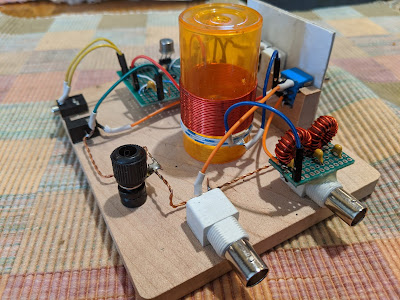 |
| Java on the S-38E Tuning Dial |
SolderSmoke Podcast #220 is available
Hunkered Down. StayInTheShack: SITS!
Flatten the Curve! It is working.
Teaching English
again – via Zoom. Kids completing the
school year remotely.
BILL'S BENCH
-- Finishing up on the
S-38Es.
-- I wrote up my alignment,
isolation and dial string experiences.
-- S-38E work is causing me some serious
legal problems. They are threatening to take down our sites and our podcast. Google
has put a CEASE AND DESIST ORDER on my blog: Check it out http://soldersmoke.com/CEASEANDDESIST.JPG
--S-38E caused me to
want to get my HRO dial receiver on the SW broadcast bands with a good AM
detector.
-- Next up: Hayseed
Hamfest cap for my Drake 2-B. And I have
an idea on how to easily broaden it for AM:
Tap the 455 kc output on the Q multiplier jack. 455 AM detector to audio amp.
SHAMELESS COMMERCE
DIVISION
PETE’S BENCH
AD9833
Phasing Rig Project
.
DEAN’S PROJECT – Step
by step. Trouble shooting. Understanding. Receiver triumph. FB.
MAILBAG
Jack 5B/AI4SV doing
well in Cyprus
Daniel SA7DER listens
during commute in Sweeden.
Peter VK2EMU building
a 6 meter amp. With Tubes
Jim WA8ZHN says there are still 7751 Novices on the books. FB.
Mike WB2BLJ modding his BITX – having a lot of fun.
Fred KC5RT – Great idea on isolation transformer in my S-38E.
Jerry Palsson: S-38C's curves vs. S-38E's exotic places. Java.
Anonymous mail: FT-8 DX -- Are these contacts legitimate? See below.
Dear
Bill and Pete:
I've been meaning to
share with you something that has come to my attention by a rather circuitous
route.
As you guys know, I've
been involved in the software/IT side of ham radio for many years. I've watched
many digital modes come and go. I've always enjoyed my work, but lately
I've seen something that makes me uneasy.
I'm sure you guys have
heard of the fantastic DX that is being worked by many guys using FT-8.
It seems like all they need to work Jakarta is a couple of watts to a wet
noodle. Shazam! Contact!
Well, I learned
something that calls into some question the legitimacy of many of these
contacts....
As i understand it,
certain manufacturers, in cahoots with a major American ham radio organization
(that happens to be very dependent on ad revenue from that manufacturer), have
secretly set up a system that combines the internet and ham radio.
Here is how it
works: Suppose Joe Ham gets on FT-8 on 40 meters. He puts out a
call using his QRP transmitter and the aforementioned wet noodle. No way
that signal is going to Jakarta, right? Well, it will with a bit of
help.
The system has SDR
transceivers and great antennas set up at strategic points around the
world -- these are really great locations -- think mountain tops near the
coastlines, always with high speed internet T5 connections. I think this
is part of the whole “contest superstation for on-line lease” business model.
One of these stations
picks up Joe Ham's FT-8 call. Sometimes it will just re-transmit it, sometimes
is will send it to a counterpart station on the other side of the globe.
Bingo, Joe Ham's signal is suddenly in Jakarta. A station there
enthusiastically responds, and that signal goes back with the same kind of
repeater/ internet assist. This is all done out of the reach of the
FCC. They are usig overseas
locations, some of them in Mexico.
Of course they have to
be careful not to "facilitate" these kinds of contacts during times
in which the bands are obviously dead, That's why 40 is so useful for
this system. Obviously they can't keep this kind of thing secret forever --
they just want to get guys hooked on FT-8, then they can reveal the system,
selling it as nothing unusual, you know, sort of akin to Echolink.
Of course, this hasn't
been made public (for obvious reasons!) but I can tell you the name of the
system: They tried to make it sound like something familiar (in
this case like APRS): They call it "Automatic Private Radio Internet
Link 1." My understanding is that when they do their “roll out”
they will offer the new service to those willing to pay a subscription.
Obviously as an
old-school, traditional ham, I'm troubled by all this. What do you guys
think? I wonder what your listeners would think.
Please don't mention
my name.. But here is a site that describes the new system:
Thanks and 73...
Please let us know if you have
any information on this, or have observed any unusual and suspicious success
with FT-8.









































